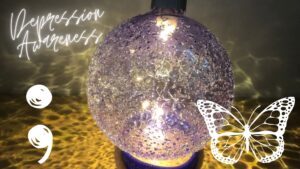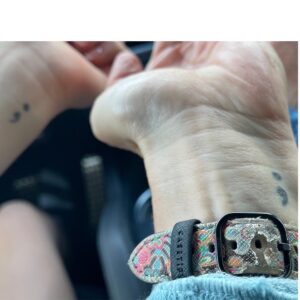
Depression Awareness: Symbolism of the Semicolon
You may have seen people with tattoos of a semicolon and wondered about the meaning…
“The semicolon symbolizes a continuation of someone’s life. The semicolon is a representation of strength in the middle of a storm. It is used as an affirmation of solidarity against a plethora of mental health issues including suicide, eating disorders and addictive behaviors.” ~ A Second Chance/Kinship
As you can hear, a semicolon is a very powerful symbol. It symbolizes a pause, not an ending, as it allows the sentence to keep on going.
It is used to create awareness about mental health concerns, to spark a conversation.
It is used to show support for loved ones experiencing darkness and storm clouds.
It is used to help those struggling to remember that they are the author of their life and they can keep going.
It is used to remember those loved ones who didn’t manage to continue.
The tag line for Project Semicolon is “Your story isn’t over“. According to Project semicolon, 1.1 million die by suicide every year.

I recently learned that 16 year old actress, contortionist and beauty pageant contestant, Kailia Posey, died by suicide.
Two days before she died, she posted two videos of herself on her contortion account. She looks upbeat and smiles and gives the camera a thumbs up – two days later she hanged herself right after her 16th birthday.
What Can You Do?
Depression awareness is so important because it can be so hard to detect. Depression can be hidden behind smiles and happy videos. It’s hard to know what someone is really going through.
If someone you care about goes “quiet” and seems to withdraw, always reach out and check-in with them. It’s not personal, it’s a sign that they are overwhelmed by their heavy emotions. Even if they don’t text back, keep on reaching out, visit them, send them a card, continue to let them know that you’re there for them. It will truly make a difference.
If your child is struggling, try to connect them to a counsellor and other mentors which could be a marital arts instructor, an art teacher, a music teacher, a mountain bike riding coach, a church youth group/youth group leader etc.
Also, if you have extended family living nearby, reach out to aunts, uncles, cousins. The more young adults you can find to connect with them, the more they’ll be able to relate and believe them when they demonstrate that life can get better.
Speak to your doctor and request a referral to a pediatrician or child psychiatrist.
In Vancouver, contact the Foundry for support.
Be proactive about mental health. From a young age, start teaching your child about their brain, and how our thoughts can play tricks on us (especially the worries and depression thoughts). (If your child is ages 7-9yrs. or 10-12yrs. I run Brain Science groups to teach kids about their brains, the worries as well as evidence-based child friendly CBT strategies.). To be further proactive, I also run an online Self-Empowerment group (ages 7-11yrs.) to teach kids about their inner power, interpersonal dynamics, self-worth, mindset etc.
To read more about the Three Causes of Depression, click here.
Depression Awareness: Symbolism of the Butterfly
Another important mental health symbol to know about is the butterfly.
When we think of the butterfly, we know it means transformation. When counselling kids and teens, I often compare depression with the journey of the caterpillar to the darkness of the cocoon to the transformation of the butterfly.
On Tumblr, there’s a well-known blog, amongst teens, called The Butterfly Project. It’s a support page for those who are depressed and self-harming.
When you read the stories and see the photos that people have submitted, you can feel the support that this page and the symbol of the butterfly brings.
These are the rules listed at the top of the page:
1. when you feel like you want to cut, take a marker or pen and draw a butterfly wherever the self-harm occurs.
2. name the butterfly after a loved one, or someone that really wants you to get better.
3. NO scrubbing the butterfly off.
4. if you cut before the butterfly is gone, it dies. if you don’t cut, it lives.
5. another person may draw them on you. these butterflies are extra special. take good care of them.
6. even if you don’t cut, feel free to draw a butterfly anyways, to show your support
Symbols, like quotes, give tremendous support.
They remind us we are not alone.
We don’t necessarily know the other people with semicolons drawn or tattooed on them. We may not know the people on the butterfly page but it gives hope that others are also going through hard times and finding their way to a lighter life.
(In my previous blog about Adolescent Development – Making Sense of the Teen Years) I wrote about Billie Eilish’s Vanity Fair interviews which demonstrate proof that the teen years can get better.
British psychologist, Dr. Julie Smith, is an amazing resource for teens and adults. She creates brilliant short videos on Instagram and TikTok, using symbols and metaphors to explain important mental health concepts and strategies. Her following on social media is over three million and she also has a very good book that I highly recommend called Why Has Nobody Told Me This Before.
This is the positive side of social media. Dr. Julie is getting very important information out, using bite sized nuggets from therapy, to millions of people all over the world! You can find her on Instagram @drjulie
Support for the Amanda Todd Legacy Foundation
Carol Todd is the mother of Amanda Todd, who died at age 15, by suicide – hanging herself, after being the victim of repeated sextortion, cyber-bullying and in-person bullying.
Almost ten years after Amanda’s tragic suicide, the trial charging Dutch perpetrator, Aydin Coban, for five criminal charges, including possession of child pornography, child luring and harassment, is taking place in Vancouver, BC.
Since Amanda’s death, Carol Todd, mother and educator, has founded the Amanda Todd Legacy Society to create more awareness around anti-bullying, sextortion, mental health and cyber safety initiatives.
She is a leader for social action and has won many awards in Canada for her advocacy work. The beautiful purple light-up ornament in the photo for this blog is one of the fundraising initiatives of the Amanda Todd Legacy. (If you wish to purchase one, it costs $15 plus shipping (approximately $11 for people in Vancouver). Purple was Amanda’s favourite colour and is the colour for mental health.)
“I have endured pain and loss. I have felt broken. I have known hardship, and I have felt lost and alone. But here I stand, trying to move forward, one day at a time. I will remember the lessons in my life because they are making me who I am. Stronger. A warrior.” ~ healthyplace.com
Warmly,

PS. Sharon’s Summer Brain Science groups and ONLINE Self-Empowerment group start this week. Click here for more information.
Want to Connect?
Subscribe now to receive free weekly parenting tips and inspiration.






